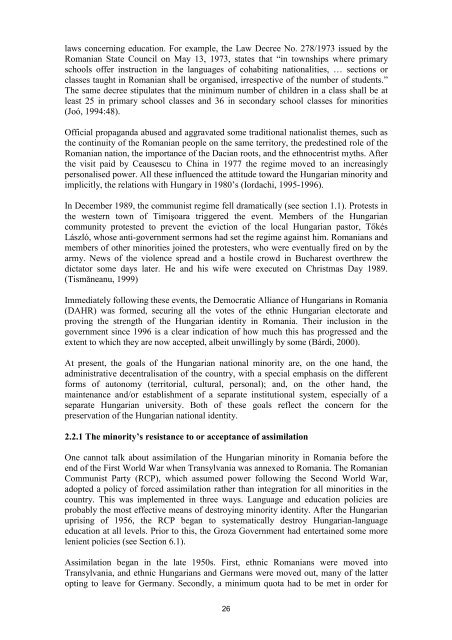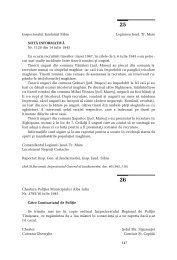Southeast Europe
Southeast Europe
Southeast Europe
Create successful ePaper yourself
Turn your PDF publications into a flip-book with our unique Google optimized e-Paper software.
laws concerning education. For example, the Law Decree No. 278/1973 issued by the<br />
Romanian State Council on May 13, 1973, states that “in townships where primary<br />
schools offer instruction in the languages of cohabiting nationalities, … sections or<br />
classes taught in Romanian shall be organised, irrespective of the number of students.”<br />
The same decree stipulates that the minimum number of children in a class shall be at<br />
least 25 in primary school classes and 36 in secondary school classes for minorities<br />
(Joó, 1994:48).<br />
Official propaganda abused and aggravated some traditional nationalist themes, such as<br />
the continuity of the Romanian people on the same territory, the predestined role of the<br />
Romanian nation, the importance of the Dacian roots, and the ethnocentrist myths. After<br />
the visit paid by Ceausescu to China in 1977 the regime moved to an increasingly<br />
personalised power. All these influenced the attitude toward the Hungarian minority and<br />
implicitly, the relations with Hungary in 1980’s (Iordachi, 1995-1996).<br />
In December 1989, the communist regime fell dramatically (see section 1.1). Protests in<br />
the western town of Timişoara triggered the event. Members of the Hungarian<br />
community protested to prevent the eviction of the local Hungarian pastor, Tőkés<br />
László, whose anti-government sermons had set the regime against him. Romanians and<br />
members of other minorities joined the protesters, who were eventually fired on by the<br />
army. News of the violence spread and a hostile crowd in Bucharest overthrew the<br />
dictator some days later. He and his wife were executed on Christmas Day 1989.<br />
(Tismăneanu, 1999)<br />
Immediately following these events, the Democratic Alliance of Hungarians in Romania<br />
(DAHR) was formed, securing all the votes of the ethnic Hungarian electorate and<br />
proving the strength of the Hungarian identity in Romania. Their inclusion in the<br />
government since 1996 is a clear indication of how much this has progressed and the<br />
extent to which they are now accepted, albeit unwillingly by some (Bárdi, 2000).<br />
At present, the goals of the Hungarian national minority are, on the one hand, the<br />
administrative decentralisation of the country, with a special emphasis on the different<br />
forms of autonomy (territorial, cultural, personal); and, on the other hand, the<br />
maintenance and/or establishment of a separate institutional system, especially of a<br />
separate Hungarian university. Both of these goals reflect the concern for the<br />
preservation of the Hungarian national identity.<br />
2.2.1 The minority’s resistance to or acceptance of assimilation<br />
One cannot talk about assimilation of the Hungarian minority in Romania before the<br />
end of the First World War when Transylvania was annexed to Romania. The Romanian<br />
Communist Party (RCP), which assumed power following the Second World War,<br />
adopted a policy of forced assimilation rather than integration for all minorities in the<br />
country. This was implemented in three ways. Language and education policies are<br />
probably the most effective means of destroying minority identity. After the Hungarian<br />
uprising of 1956, the RCP began to systematically destroy Hungarian-language<br />
education at all levels. Prior to this, the Groza Government had entertained some more<br />
lenient policies (see Section 6.1).<br />
Assimilation began in the late 1950s. First, ethnic Romanians were moved into<br />
Transylvania, and ethnic Hungarians and Germans were moved out, many of the latter<br />
opting to leave for Germany. Secondly, a minimum quota had to be met in order for<br />
26









